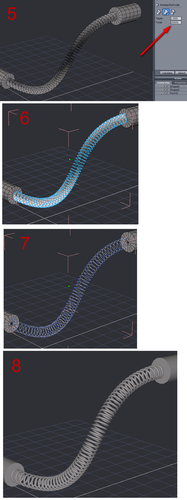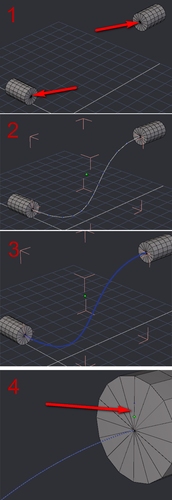Creating 3D helix
Thought I had shown this, but here is a quick (once you know) way to create a 3D helix in Hexagon:-
1:- 2 cylinders just for start/end of 3D helix
2:- Create 3D path. Collapse DG when path in correct position.
3:- Increase number of points on path (I made it approx 500)
4:- Create line at one end of path
5:- Sweep line along path and add twist (I made twist 20000). Collapse DG when done.
6:- Select outer edge_loop of sweep
7:- Copy/paste which leaves new helix path (I have hidden sweep so you can see helix)
8:- add thickness to helix path (add sub_d if needed)


B.png
674 x 1800 - 576K


A.png
515 x 1500 - 302K


Comments
Grazie
m_m_
:-)
nicely done Steven thank you
Do you know what my big problem? (in addition to not knowing the exact use of the English language)
Do you know what it's hard for me? (excluding the exact pronunciation of the English language)
Divide the 3D path with equidistant points.
I tried to create a path consisting of 3d baselines not equal to each other and this creates (to me) problems.
Help......
Grazie
Example:
how do I get a lot of points equidistant without the use of tool "bend"?
Thank you for your help.
There is no tool in Hexagon to do that.
There is no tool in Hexagon to do that.
Perfect.......
:long:
Grazie.
Bye
Hi m_m_italy,
Expand your toolbox by using NVIL (Voidworld) for making things like cords. http://voidworld.cmcproductions.co.uk/index.php?board=2.0 (currently free )
Quick example from NVIL.
Thanks Steve.
I do not know this possibility.
I downloaded the compressed file.
If you do not create problem, can you explain what should I do?
thanks
I correct.
I saw.
I do not like a toy.
Thanks for this indication.
We understand little but I try.
Bye
Post scriptum:
Interesting but difficult for someone like me who does not know English.
I am pleased that so many software makes it easy modeling.
Blender, Wings, SU, NVil etc. etc....
But.....
But.....
I, however, I hope this small chance, come sooner or later also inserted in Hexagon.
thanks again
sorry for super strapessimo mio inglese
Hi Steve:)
Very cunning method - thanks for sharing.
There is no tool to divide a path with equidistant points, but there is a method.
Draw the curve and draw a straight line the length of the curve. Tessellate the line to the number of points required, then bend it using the original curve.
BTW - how do you get 500 points on the curve? I have seen a method by E-Z to quickly tessellate a curve, but can't for the life of me remember - all I can do is repeatedly select and tessellate. The subdivide tool won't go above 20.
I did find that using the smoothing tool, under surfaces I could get an approximate equal distance between the points.
(The original curve is in yellow)
But I have no idea on how many points there are.
So that would be by trial and error with the range selector, until one finds something that can be used.
Plenty good enough for making a twisted cord.
And in real life there are always some stretching in a cord like that.
Metod positivo but no perfetto.
Bye
Post scriptum:
Does not always produce satisfactory results.....
Post post scriptum:
But I try again.....
Grazie
Esatto:
"That only works on 2D planer curves, not on 3D curves."
:red:
I pray DAZ:
insert command......
Thanks.
Thanks, Varsel - I think that is the method E-Z showed. Just playing with it, seems the cubic subdivision works best.
Yes, Steve - sadly it is true that it only works on 2D curves - darn!
The night brings advice.....
:cheese:
lines:
one by one
:long:
then
constructed path
then
added points
then
applied system "Steve"
then
touch-up
Ciao
Hi m_m_italy,
Looking very good.
If the path is only 2D, then use "Bend" on an Helix.
1: Create Helix + Path
2: Increase number of points on path (<- important. The more points the better for bend)<br /> 3: Bend Helix to path (scale if needed)
4: Add curves to ends of Helix for connection. Weld them
5: Add thickness to Helix.
Ciao Steve.
Thank you.
Your method is excellent.
Interesting point two.
It would be nice to be able to slide the points along the line without distorting it ....
Fare scorrere il punto lungo la linea senza deformare la linea......